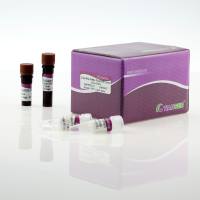Cloning of Taq polymerase-amplified PCR products
互联网
实验原理
The plasmid vector (pCR®II-TOPO® or pCR®2.1-TOPO®) is supplied linearized with:
Single 3´-thymidine (T) overhangs for TA Cloning®
Topoisomerase I covalently bound to the vector (referred to as "activated" vector)
实验步骤
1. Producing PCR Products for TOPO® TA Cloning
2. Optional Protocol with Platinum® Taq DNA Polymerase High Fidelity
2) Mix contents of the tubes and overlay with mineral or silicone oil, if necessary.
3) Cap the tubes and centrifuge briefly to collect the contents.
5) Perform 25-35 cycles of PCR amplification as follows:
6) Maintain the reaction at 4°C after cycling. The samples can be stored at -20°C until use.
1) Electrophorese amplification reaction on a 1 to 5% regular TAE agarose gel.
2) Note: Do not use TBE. Borate interferes with the NaI step (Step 2).
3) Cut out the gel slice containing the PCR product and melt it at 65°C in 2 volumes of 6 M NaI.
4) Add 1.5 volumes Binding Buffer (provided in the S.N.A.P. ™ MiniPrep Kit).
6) If you have solution remaining from Step 3, repeat Step 4.
7) Add 900 µl of the Final Wash Buffer (provided in the S.N.A.P. ™ MiniPrep Kit).
8) Centrifuge 1 minute at full speed in a microcentrifuge and discard the supernatant. Repeat.
9) Elute the purified PCR product in 40 µl of TE or water. Use 4 µl for the TOPO® Cloning reaction.
4. Setting Up the TOPO® Cloning Reaction
1) Mix reaction gently and incubate for 5 minutes at room temperature (22-23°C).
Note: You may store the TOPO® Cloning reaction at -20°C overnight.









